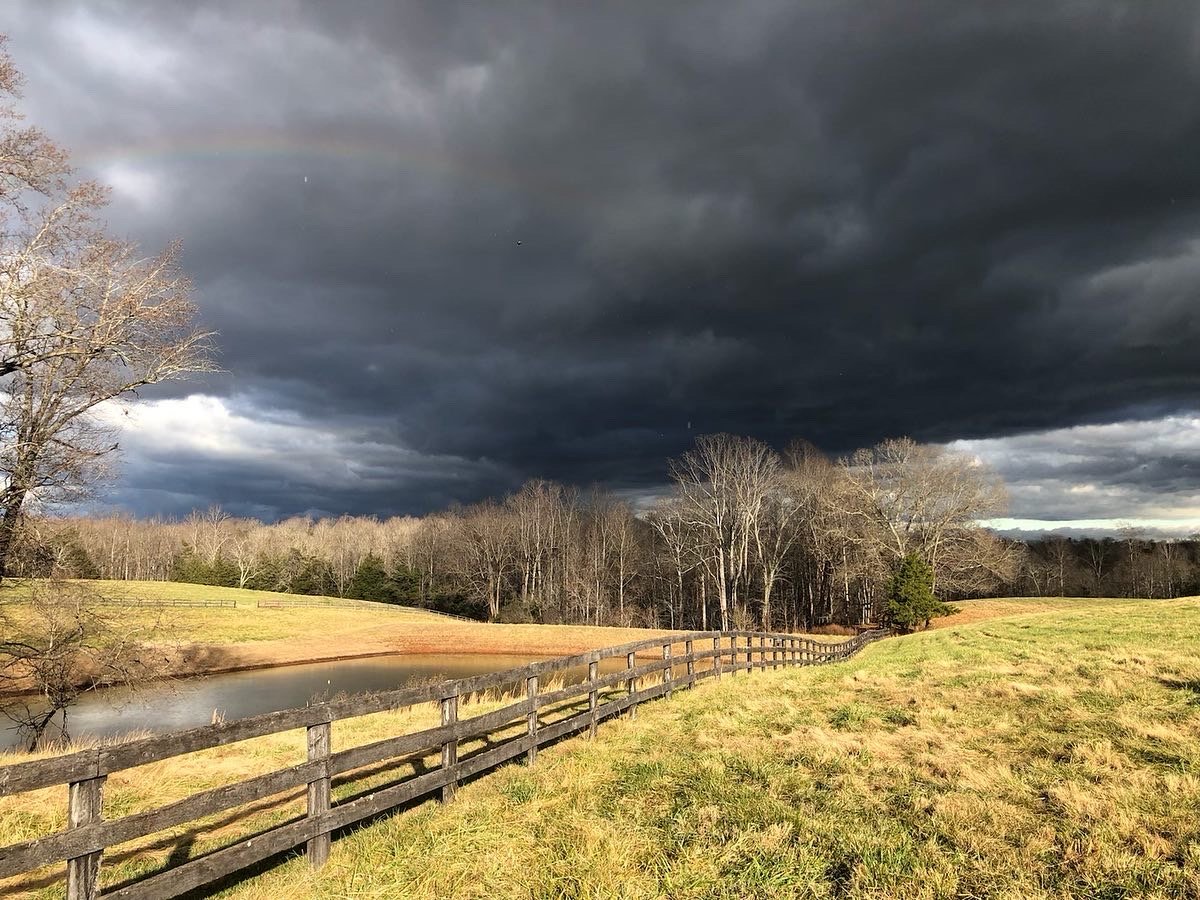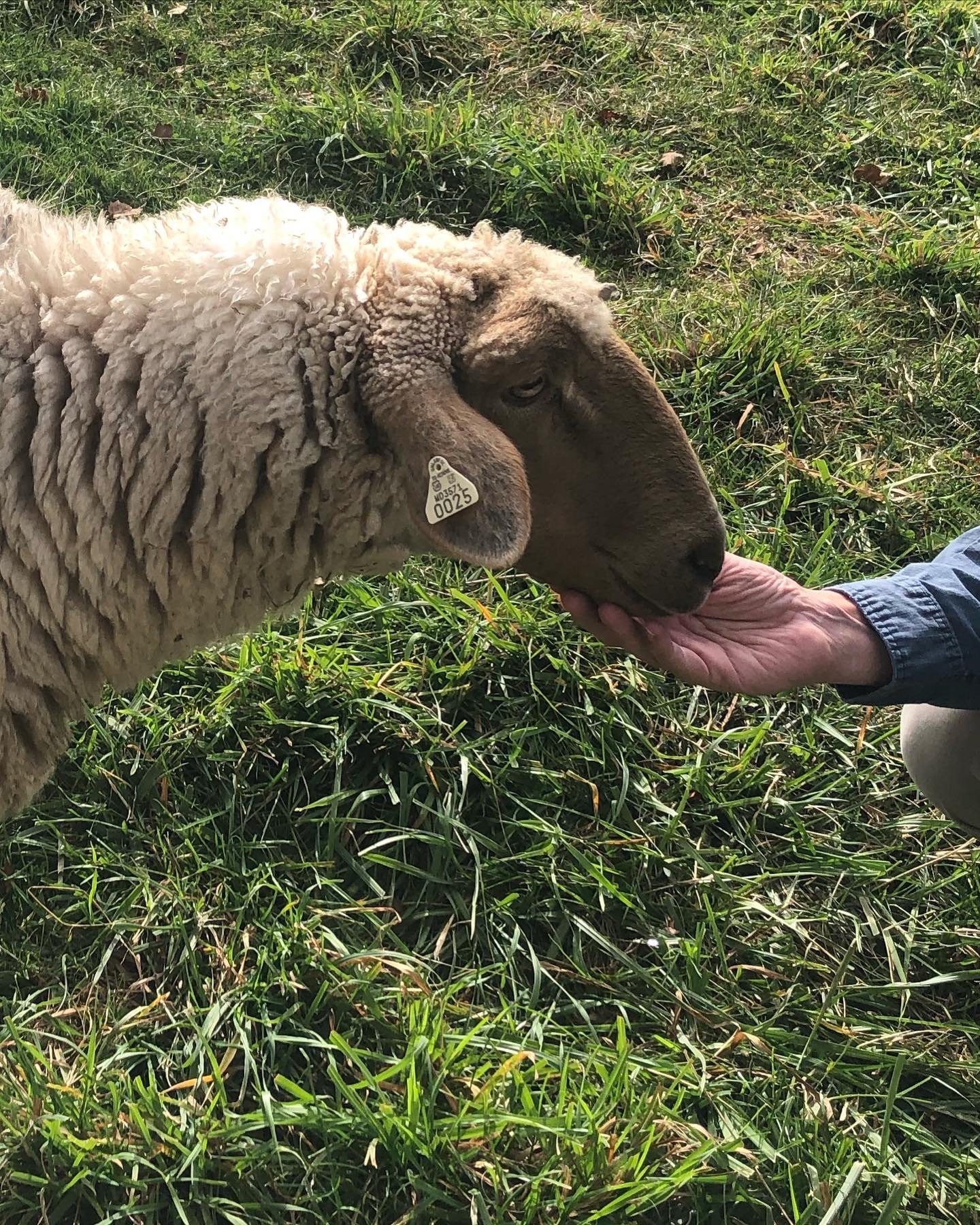Where We Landed and Other Stories

I cannot believe more than a year has passed since I sent out a newsletter. It was an eventful year. My daughter graduated from high school, we lost one of our beloved dogs, Giallo to cancer, and we sold our house on Bainbridge Island and moved to Central Virginia to a 90 acre farm.
My husband and I looked for a farm for quite a while looking at property virtually from Southern California up the coast states all the way to Whidbey Island, Missouri, Tennessee, and the East Coast from South Carolina up through upstate New York. We ended up back in Central Virginia due to the long grass growing season, upwards of 300 days of grazing, the mostly benign weather—not too cold, and usually not too hot, but who in the US can even say that now, a thriving local food movement, and a very active fiber shed, The Chesapeake Fibershed. We found a property that is about half forest and half pasture with run-in sheds, barns and a former equine veterinary clinic where we now live. Its horse surgery and recovery room are perfect for processing wool and making felt and dyeing because of high ceilings, concrete floors, and floor drains.
We left Bainbridge at the end of July and drove across the country with our dog, our daughter and a friend of hers from high school. Both Linden and her friend were driving his car across the country to their respective colleges located in the northeast. My husband, the dog and I made the trip in our electric car stopping at various charging stations along the way and we all met up at night for dinner at various airbnbs along the way. We found traveling by electric car an interesting experience in that you often meet interesting people at the stops who are willing to chat, and you often see the same people multiple times along the same highway. The first half of the trip was exceedingly hot, 109 degrees on the highway into eastern Oregon and it didn’t cool off until we reached Kentucky. If you want to see where we traveled you can look at my instagram site @withneedleandstick.
A page from my travel journal
After dropping our daughter at college, the real work began of unpacking and cleaning up and repairing barns in preparation for animals. My beloved horse of 17 years arrived from Seattle at the beginning of October. In the meantime, we began visiting farms around the area to look at how people here were keeping their sheep and to see the breeds in person.
We have found the sheep and goat farming community to very open and hospitable in general. The farmers are very generous with their time and sharing their knowledge. The first farm we visited had Clun Forest sheep, a heritage breed. These attractive sheep are white with upright black ears, black faces and clean black legs. However, we found the sheep to be quite spooky and could not get close enough to even touch them or examine their wool. My husband and I are looking for a breed that is docile, friendly and easy to handle since much of their care will fall to me, and as a someone of a slender build, I need a sheep I can easily work around and handle by myself.
The next farm we visited was in Dickerson, MD where we met with the farmer Ken Farrell of Foxdale Springs Farm. We told of our experience with the Clun Forest sheep. His reply was, “Well, all sheep can be spooky and like to flock together.” As we entered the field with him, his Tunis sheep ran up to meet us and get chin scratches and to nibble our pants.
My husband and I fell in love with these sheep. We found them to be docile, friendly and quite attractive. Their wool is thick, creamy and crimpy, and ranges in length from 3-6” and has a fiber diameter of 24-31 microns, which is considered a medium wool. However, if bred for fiber quality, many people can happily wear the wool next to their skin. The lambs are born red in color and turn creamy as they age. Their faces and legs lighten to a softer shade of red as they age. Best of all, they have traditionally been raised in the southern US and are heat tolerant and parasite resistant and make great mothers that will lamb easily out in the field. We “ordered” 5 lambs from Ken, and we are hoping to be able to pick them up in early June. I also talked to a woman in southern Ohio about getting a ram lamb and a couple of ewe lambs for genetic diversity. Of course it all depends on the success of the breeding season and the lambing. We are looking forward to the arrival of sheep on our farm.
Felting Experiments and Goats
I was able to experiment with felting many types of wool while still in Bainbridge. I was able to find a needle felter in Woodenville and spent the day laying up roving and sending them through the felter. I soon learned the wool samples can get quite stiff. I quickly realized that the best approach may be to blend wool with alpaca or mohair.
Once we settled here in Virginia, a friend who keeps Navajo-Churro sheep introduced me to a goatherder, Pat Harder. Pat has raised Angora goats for more than 30 years on a nearby farm to us, Kid Hollow Farm. She started with just three white bottle babies, but soon became enamored of the colored angoras. I now have two white does, one colored doe, and two colored wethers from her flock. I have fallen in love with the beautiful goats. The bellwether, Hattie, is the boss that rules the flock and tells me what’s what. She always makes her needs known, whether it be for more hay, that she is ready to be fed grain, or that she just wants a visit from me. Hattie is very vocal and quite the character. Each goat has their own personality. Hazel, the other white doe, is quiet and shy but has really become attached to their guard donkey Blaze. If I move the goats to a new field before moving Blaze, Hazel will run back and forth between her flock mates and Blaze, and she often sleeps right next to his fence area. Angus is a small friendly wether who likes to nibble my coat and ask for cookies, while Clarabel hangs shyly back, and Chuck just likes to eat.
They will be shorn in January, so I will soon have my first fiber crop.
Clarabel, Angus and Chuck playing “king of the rock”.
Hattie adjusting to her new farm.
More Felting Experiments
I found a makerspace here in a nearby town that unbelievably has all of the equipment that I have been looking to buy: a Feltloom needle felter, a motorized drum carder, and a welt felter. I recently joined the facility which is much like BARN, and completed my training given by a very experience felter, Lisa Jacenich, who has been working with Kazakhstan government to help keep their tradition of felting alive and vibrant. She recently closed her store and donated her equipment to the Staunton Makerspace to teach others to felt. It just feels like the whole process was meant to be!
I just spent the day blending wool and mohair and felting the samples as the first step in developing me boiled wool felt fabric. I was really excited to see that my idea of a wool/mohair blend was feasible and results in a beautiful lofty felt. I have lots more work to be done, but it is a start.
My new year plan is to make my first felted fabric and a coat from that fiber for the Chesapeake Fibershed’s 2023 Sustainable Cloth Challenge using my own mohair and wool from a friend’s local farm.. I will update you on my progress toward this goal.




